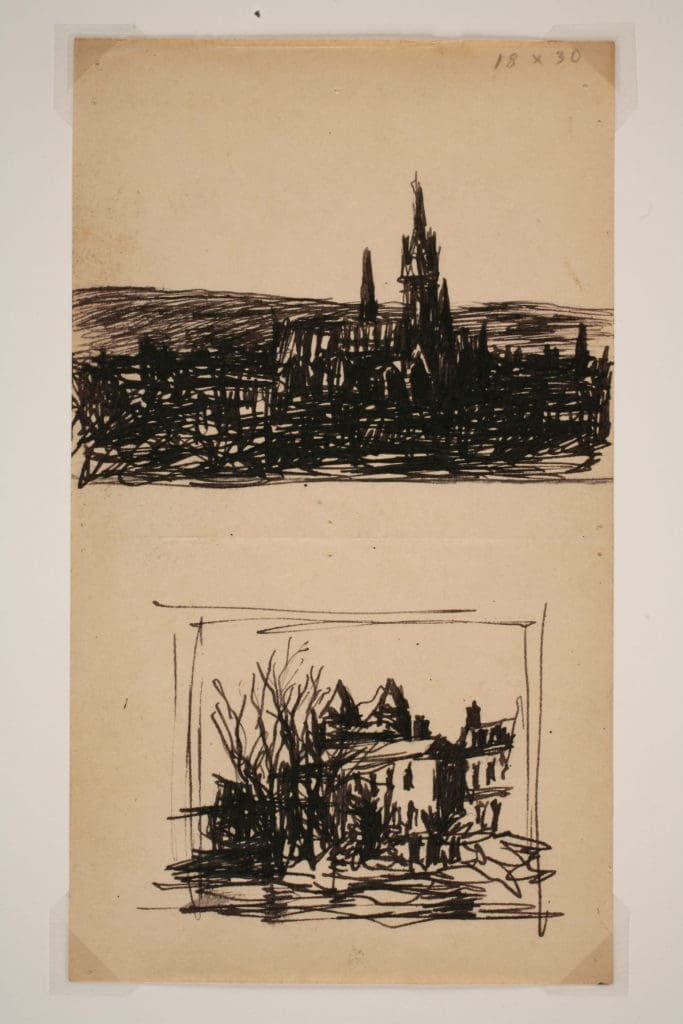Everyone wants to make their mark on life. Learning to express yourself on paper is one way to do just that. Explore many ways to draw, paint, and make your own mark. Along with the many mark-making exercises this month, this PDF offers more drawing exercises.
Drawing without a Pencil
When you think of drawing, you might assume you need a pencil. There are many types of drawings that don’t need a writing utensil at all. You can rip the paper with your hand. This is a great way to make an abstract pattern, but you can also make something that is representational. Scissors give you the same effect but with cleaner lines. You can also use tape to make lines. Tape drawings can be geometric, but you can also mold the tape to make curves. Finally, tracing objects or drawing shadows can create an abstract drawing. All these methods are wonderful ways to be creative without the fear that you can’t draw. After all, we made multiple drawings and there wasn’t a pencil around.
What do you need? Start with what you have. Drawings are about making a mark on a surface. A smooth rock can be pulled through sand to make a drawing.
Try This: Spend the week making a different pencil-less drawing each day. At the end of the week, explore what you made? Which ones did you enjoy making? What did you think about your drawings?
Collection Connection:

Arthur Secunda is well known for his torn paper compositions. He uses this nontraditional fine art media to create landscapes, portraits, and abstract compositions.
- Explore Night Bird.
- Have you ever see a bird like this?
- If this bird would flap its wings, how would it look? Sound?
- Are the feathers realistic? Explain your answer.
Drawing Together
Drawing is often a solitary hobby. But, creativity can be expanded through collaboration. Drawing alongside someone can be a nice way to improve your skills, like if you both draw the same object. You can learn something new about your drawing partner. Spend time sketching them; and let them take a crack at drawing you. Drawing games are fun. You can work together on a drawing, hiding your half until the reveal. You can also make lines for them to complete into a finished drawing. Or you can work together to draw something out of your shared imagination. Drawing is a nice way to spend time together.
What do you need? Paper, some markers, and a friend.
Try This: Explore how your drawings look different when you pair with different people. Try the same exercises with paint instead of markers. Talk to your partner about their feelings about these exercises. How do those compare to yours?
Collection Collection:

Gilbert and George have been making art together for 50 years. They’re well know for their large-scale photographs that blend self-portraits with bright objects and colorful backgrounds. Imagine making an artwork with your best friend about your life. What would be in the image?
Drawing a Mess
Drawing shouldn’t always be clean. Turning a mess like a spot or a splatter into a drawing can help you move outside your comfort zone. Combining watercolor and ink is a nice way to explore line and color. Taping off parts of the paper can create a resist, and no worries if your paper rips a little. A mess can be beautiful too.
What do you need?: Gather paint and/ or ink, brushes, pens, washi tape, and a smock. You might also want to have some napkins on hand.
Try this: Give yourself permission to get messy. Keep pushing yourself to get even messier with each drawing. What does it feel like to push past your boundaries?
Collections Connection:

Monoprints have aspects of painting and printmaking. Like painting, each image is unique. However, in monoprints, the artist makes the image on a plate, places a sheet of paper over the image, and then applies pressure. If you’ve ever made bubble wrap prints, these are monoprints. Matt Phillip’s print shows the immediacy common in monoprints. The artist was focused on expression instead of showing fine details.
Drawing Big and Small
Drawing is a lifelong hobby. Most of the time you might work a certain sized paper. If you really want to stretch mix the paper size up. Drawing very tiny can help you focus on each dot and line. Drawing very big can help you loosen up your lines.
What do you need?: Large markers and a big roll of paper and fine markers and average-sized paper.
Try this? Here are some ways to draw big and small.
Collections Connection:

How large would you imagine this work to be? Look at the details in the image. Scores of lines and dots come together to make the figure and the bird. This arresting composition is only 2 1/4 in. x 1 1/2 in. Surprised? Can you make a stamp-sized work that feels monumental?
Collection Connection

[Sketches of France], c. 1944-1945.Gift of Mrs. Louise Faysash 1996.34.1-51
Raphael Gleitsmann drew these quick pen drawings when traveling in Europe. Neither sketch is detailed, but they are realistic.
Family Days are made possible by PNC with additional support from The Kathy Moses Salem Philanthropic Fund of the Akron Community Foundation, The R.C. Musson and Katharine M. Musson Charitable Foundation, and the Robert O. and Annamae Orr Family Foundation.




